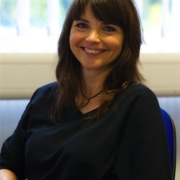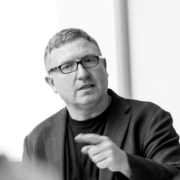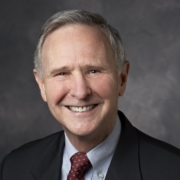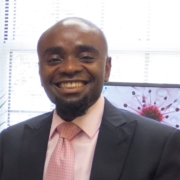Sarah Dryden-Peterson
Learning from Education in Emergencies
The COVID-19 pandemic has created an emergency situation for most education systems worldwide. Schools are closed. Students are at home. Stress and anxiety are high. Domestic violence and food insecurity are on the rise. And we are uncertain when this emergency will end.
Luckily, there is a large body of research on education in emergencies that can help guide us through this unprecedented situation. My guest today is Sarah Dryden-Peterson, a foremost scholar on education in conflict and post-conflict settings.
Sarah Dryden-Peterson is an Associate Professor at the Harvard Graduate School of Education. She is the co-founder and director of REACH, a collaborative initiative that provides guidance and resources on key topics in education, migration, and displacement for educators, policymakers, and researchers. She has recently started Books of Belonging, an online video series where she reads a picture book each day of the week.
Citation: Dryden-Peterson, Sarah, interview with Will Brehm, FreshEd, 199, podcast audio, May 18, 2020. https://freshedpodcast.com/sarahdrydenpeterson-2/
Will Brehm 2:07
Sarah Dryden-Peterson welcome back to FreshEd.
Sarah Dryden-Peterson 2:09
Thanks, Will. It’s great to rejoin you.
Will Brehm 2:11
So, was there a moment for you when you realized that your specialty in education and emergencies was going to be vital for this pandemic?
Sarah Dryden-Peterson 2:20
That’s a great question. I’ve actually reflected on that a fair bit. I really remember the last day that I picked our kids up from school on what, in the end, would end up being their last days together with their teachers and friends of this school year. Where we live, in Boston, it wasn’t clear yet that schools would be closing. But I realized when I was picking them up on that day that I was looking around differently. Kind of the way you do in moments that you want to remember, or that you feel might be different. Taking in every detail. Trying to grab on to that kind of “togetherness” of the learning communities.
Will Brehm 2:55
Hmm. So, was there some details that you specifically remember?
Sarah Dryden-Peterson 2:58
I remember looking in the mirror -I was picking the kids up in the car- and seeing our daughter, our older daughter walks towards me carrying all of her books and kind of saying goodbye to her friends and wondering whether there would be a time when they would be back together the school year.
Will Brehm 3:16
Yeah, it’s really, it’s quite amazing. I mean, just the level of uncertainty that has sort of become so normal, for so many people, at so many different levels because schools, as you say, have closed now. And obviously, I guess some policymakers are currently trying to think about opening them up again, which in some cases seems a bit strange, but it is a conversation that is being had. And I’m wondering, in other cases of conflict that you’ve studied and looked at, why did schools close? I mean, this time, it’s obviously a pandemic, but what has happened in other cases?
Sarah Dryden-Peterson 3:50
So, I think this is obviously one of the hardest decisions that educators and education systems can make to close schools. And really thinking about the right to education, the continuity of learning, all of the goals that schools represent for kids, teachers, families, and communities. And really, the decision to close schools gets made when the harm caused by keeping schools open has the potential to be greater than the benefits that kids are gaining from being at school. So, in conflict settings, we see the kinds of harms that schools can cause in often very visible ways. So, when schools are the target of bombing, when schools are occupied by armed forces, when children are experiencing violence on their routes and walking to school, and children and families and teachers see this kind of harm in a very visible way. I think what’s been different with this pandemic is that children experience their schools closing often in the absence of any kind of threat that they could see. This invisible kind of illness -schools closed in a preventative way. And so, it was often unclear to them what harms were being addressed by closing of schools.
Will Brehm 5:08
Yeah, it seems like the closure, it was the idea it was “in the mind”, right? We had to imagine this threat without, at the time, maybe even knowing anyone that had the virus. Or having very few stories of the virus in the communities in which we live.
Sarah Dryden-Peterson 5:23
Right, exactly. And I think for those who live in places where school closures are a rare occurrence, and in fact, something that many students and parents have never experienced in their lifetime, it was really a kind of unimaginable situation that schools would be closed and particularly that schools would be closed for an extended length of time.
Will Brehm 5:45
So, in previous conflict settings that you’ve examined how long are schools typically closed for? I mean, this is a big question that so many people seem to be wondering. Is it going to be a few weeks? Is it going to be months? Are we talking a whole school year? Everyone seems very worried, and honestly, it’s very difficult to get much answer out of governments in the US, in the UK, where I currently live. I know Japan has had some difficulty getting some clarity on how long schools are actually going to be closed for. So, based on the research in other conflict settings, what do we know?
Sarah Dryden-Peterson 6:20
I think this is one of the things that’s become particularly apparent to me having worked in education in crisis and conflict is that I was beginning to see patterns in what we might expect for school closures. Both the fact that they would close and then this idea of the duration. So even at a very personal level, I started asking our older daughter to bring all her school materials home from school, in advance of schools closing because it seemed like it was very clearly on the horizon that that might happen with the inability to go and retrieve those materials. And this idea that when schools closed, they’re often closed for a lot longer than we ever imagine that they might be. So, the kinds of disruptions to schools that I have experienced, having grown up in Canada and lived in the Eastern US for a long time are really weather-related. And so, they’re short-lived, you can imagine when they’re going to finish, and don’t need to engage in the kind of preparedness that we have seen the need for here. And I think like in conflict settings, most people imagine that the disruptions that they’re going to experience are going to be short-lived. And so, we talk with refugee families who when they flee their homes, imagine that they’re going to be returning within a few weeks, or a few months, and then realize that the experience of displacement and the kind of conflicts that cause those displacements are quite long standing and the average conflict now lasts between 10 and 25 years. Of course, that doesn’t mean that schools are closed for all of that time. But I think the main point is that while we think school disruptions will be short-lived, they’re almost always longer than we anticipate.
Will Brehm 8:02
It just seems so traumatic, that the idea of anticipating going back to something in a few weeks, and then inevitably learning that it’s actually going to be much, much longer and perhaps an uncertain amount of time in the future. I mean, the sort of traumatic experience that must have caused people and I think is causing people today is just so difficult, I think, to begin to grasp and maybe we’re going through some sort of collective trauma right now.
Sarah Dryden-Peterson 8:32
I think that’s right. And I think it is this kind of unpredictability that you’re talking about, or uncertainty, that’s so hard to wrap our heads around. And we certainly see this in conflict settings too that it’s the unpredictability of knowing if, or when, schools will be closed or if, or when, schools might reopen that is so hard to then put the pieces of everybody’s life back together around. And in conflict settings, we see this kind of unpredictability of violence. So, schools and children and families living with this uncertainty of not knowing if their schools would become a target. And so not being able to have all the information that would be necessary to make these kinds of decisions. And, of course, while conflict settings and pandemics are different in very tangible ways, I think this unpredictability is what we see as constant across. So, like there’s so much that we don’t understand about COVID-19 in terms of predicting what the harm might be of gathering children in places like schools and whether the benefits might outweigh those harms. We see this kind of uncertainty and predictability in conflict settings as well.
Will Brehm 9:44
And obviously, that very particular issue would make planning for education at the system level almost impossible. Like we don’t know a lot of the sort of basic questions around the virus itself. It’s very hard to sort of plan the institutions of society. And yet, we have a lot of global institutions like the Global Education Coalition, and Education International, the Global Federation of Teacher Unions, they are beginning to put out guidance for reopening schools. So, they’re trying to begin planning even or in spite of the uncertainty in which we live. I’m not sure if you’ve read these school reopening guidance that these different groups have put out, but what do you make of it? On your general read, what’s good? What’s bad? How do they compare? How do you make sense of these reopening plans?
Sarah Dryden-Peterson 10:40
I think what’s really productive about the guidelines that we’ve seen come forward so far is that they are very explicit about the incomplete information that we have and the uncertainty with which school systems are working. And so, this idea that instead of rejecting the idea of uncertainty and making certain plans because it’s easier to do so of really framing guidelines around needing to work with uncertainty and what some of the ways in which we can productively address that uncertainty. So, as I read these guidelines, I see this really clear focus on making decisions that are contextualized. And that are able to go through processes of continued adaptation depending on what the circumstances are. I also see a real focus on thinking through equity concerns no matter what the scenarios are. And both of these sets of guidelines that you mentioned, I think, are also filled with the kinds of questions that we need to be asking ourselves. And even rhetorically, I think this is a really interesting strategy because when we are in situations of uncertainty, one of the most important things we can do is ask questions. We don’t need to pretend that we have all the answers and in fact by figuring out what the right questions to ask, we can make movements on how we collectively can answer those kinds of questions.
Will Brehm 12:07
What kind of questions would these be?
Sarah Dryden-Peterson 12:09
I think they are questions about what kind of knowledge do we have? And how can that information helps us to answer this question of whether there are tremendous health risks to gathering children in places like schools. And those questions are very contextual. And they may vary not only from country to country, but from school district to school district, and even from school to school. And so, thinking about questions related to how we share knowledge, how we’re transparent about the kind of public discussion that happens related to the factors that are being considered when schools are opening or not. I think also these questions around what are the equity implications of any kinds of decisions? Are decisions, either to close or to reopen schools, differentially impacting students in different communities? Both of the sets of guidelines make reference to very particular health and hygiene kind of requirements that would need to be in place and yet, of course, there are millions of children globally who don’t have access to running water in schools. And so, as we think about whether or not it is safe to reopen schools, we have to think about these very important health considerations and what’s possible in each different context.
Will Brehm 13:29
Yeah. Big questions and obviously contextually specific. What about when we talk to children themselves? How should we be talking to children about this pandemic? Are there lessons from other conflict settings that we can sort of think through to help guide us when we do talk to children, particularly younger children, about this very unusual moment we’re all living through?
Sarah Dryden-Peterson 13:55
I think there are. In refugee settings we find that children who learn about the histories of conflict -and the causes of conflict, and why they’ve needed to flee their homes- are really able to better cope with the uncertainty that we’ve just talked about. To be able to learn, and importantly, to be able to think about the role of their education in their future. And really, as they are trying to understand why they needed to flee their homes, the origins of the discrimination they face as they’re trying to build new lives, children feel better able to learn because they have a solid grasp of what’s going on around them. I think this also comes back to children understanding why schools are closed. So, this idea that they need to understand even in the absence of being able to see what’s going on, very tangibly. The science of COVID-19, the reasons for social distancing including school closures, and the kind of action that they are taking by learning remotely and their agency really in preventing the spread of this disease. And I also think coming back to the kinds of questions that the guidelines are asking us to consider in terms of reopening. It’s important that young children but all young people really understand the social and political responses to the pandemic. So, I think of course, we’re relying on epidemiologists to help us understand how to track and predict infection. But the kinds of decisions that we’ll need to make about schools opening will have to involve careful thinking about how to manage health risks in the context of other kinds of learning goals and goals of being together. So, this pandemic really provides an important opportunity for families and teachers to help children think through the kinds of factors that go into these decisions. And I think in particular, this is critical because the pandemic has exposed such long-standing structural inequalities including devastatingly unequal effects of who COVID-19 is affecting. So, it’s really an opportunity for children and young people to grapple with how the policies and practices that we adopt affect people differently. And then what the ethical questions are of what we owe to each other and what kinds of actions we therefore take as a result.
Will Brehm 16:20
What about some more emotional and mental stresses that children and youth must be facing through this? I mean, I agree that talking to children about the inequalities that exist and how to think through this pandemic and rethink our social institutions, but students/children must be feeling so many emotions that are probably difficult to understand. So, how can we begin to talk to children about and help them process those emotions?
Sarah Dryden-Peterson 16:50
And I think this is one of the reasons why it’s so hard that schools are closed. Because schools play such an important role in the social and emotional development of children. The idea of being together and being able to come up with ideas and support each other, the role that teachers play in talking through hard feelings. And obviously, so much of this also goes on in families and the ways in which we can really prioritize how we think about the stability that we try to create for children, the kinds of routines, the ways in which we can constantly show children that despite the uncertainty around them, help them think about what in their life is predictable, and how that kind of predictability can help them actually form a foundation to engage with the uncertainty in ways that feel productive. And I think one of the real ways that we have seen in conflict settings to help children and young people really think about present uncertainty and cope with that present uncertainty is to link it to the future. So, in some ways, this seems kind of counterintuitive because we think, “Okay, we’ve got to focus on the now and the immediate kind of crisis.” But when we ask refugee children and families about the purposes of education, they always have one clear answer. And that is about education really helping to make a future. So, when disruption happens, when people experience uncertainty, this idea of having a long-term purpose can be even more important than it is in a kind of stable context. And so, I think this is an important way that teachers and families can really think about the kind of learning that we do now not as a “stopgap measure” until things return to normal but instead, that the future of learning and the future of many parts of our lives may look different. And so, as parents and teachers, we can help our young people to have the kind of predictability and stability of love and care and routines, but also help them gain the skills to navigate this kind of uncertainty with that foundation of trust and knowing that we will help them and work together to build futures that they can still be hopeful about
Will Brehm 19:11
-and participate in creating, right? It would be co-produced rather than by the adults.
Sarah Dryden-Peterson 19:18
Exactly. And that they have a critical role in building what these futures will look like.
Will Brehm 19:23
Yeah, right. It’s such a nice way to get beyond this moment. Even personally, sometimes I feel, on the one hand, so focused on the immediate and then at the same time, I think about the past and then I think about two weeks from now and what the infection rate will be and, so in a sense, time is all out of joint in a way. And beginning to think about that future somehow feels right, I guess. It’s hard, but it does feel right and something we should not be doing now. Even though I know it’s pretty difficult. So, the other issue here is that you know, children today are at home with their parents or maybe extended family or wherever they live, but certainly not with their teachers. Their teachers are also locked up at home and maybe with their own families. So, during this pandemic, during this crisis, during this moment of conflict that so many of us are experiencing now, what role do teachers play in the process of education and online learning and as parents are trying to navigate the emotions of their children, the learning of their children -what role do the teachers play today?
Sarah Dryden-Peterson 20:32
Teachers are obviously a cornerstone to this kind of hopeful future and co-constructing and helping young people to build those futures. And it’s also true just like you said, Will, that we’re all grieving this inability to be together in classrooms and to be together in school yards. And of course, the millions of teachers globally who are teaching from home are also missing these kind of connections that make teaching the kind of joy that it really is. And yet I think what is so hopeful to me in this is that we see teachers reaching their students in all kinds of new and innovative ways. One of the projects that we’ve been engaged with our REACH initiative, is to really look at how students and teachers are creating new ways of learning together during this pandemic.
Will Brehm 21:22
And what do you find?
Sarah Dryden-Peterson 21:23
So, some of the work that we have engaged in to look at, for example, what teachers of Syrian refugees are doing in Lebanon. Seeing short videos that teachers are creating with everyday kind of lessons, but also thought-provoking questions that students can think about. Or a team of teachers in South Africa showing how teachers are creating ways to check in individually with their students over WhatsApp where they can actually be able to see if students are having a hard time engaging and then figuring out what they need, not only in terms of their learning, but also if they might be struggling with food or with security of shelter and economics at home. And I think that while in times of crisis, we’re tempted to think about short term initiatives. We’re also tempted to think about really standardized approaches to education. And I think this kind of widely accessible approach to education is really important in terms of providing a foundation of reaching all children. And during, I think the most comparable kind of example, when we think about the Ebola crisis in West Africa in 2014, teachers were really able to reach their learners via radio because everyone was incredibly isolated in their homes, like now. And over the past several months, we’ve seen these kind of standardized centralized approaches across China with television education. But as we’ve been documenting in Ethiopia and is clearly true in other places, these kind of distance learning strategies can also fail to reach the most marginalized students, especially those in rural areas and those who have no electricity. And so, I think that what we see is that this pandemic provides us an opportunity to give teachers more time and more autonomy to play, really the most important roles that they play. They know their students. They know how to engage their students in dialogue, to continue building relationships, and to adapt the teaching that they’re doing to the specific needs of their students. And in conflict settings, we see teachers engaged in these processes from a distance as well that are really focused on relationships, and on very local level endeavors that teachers and communities are initiating. So, for example, teachers dropping off materials to the homes of Palestinian children who are trapped in those homes during the Second Intifada. Or Somali teachers who’ve moved away from the refugee camps where they used to teach but who have ongoing relationships with their secondary school age students over Facebook to encourage them, to help them learn particularly challenging materials. And I think what this really points to is that in a time of uncertainty like the one that we’re in now, education is at its most effective when it does focus on these relationships of belonging. To make sure that all children and young people feel connected, that they feel secure in their relationships, and this sense of purpose, feeling a shared sense that they together can help build for the future. And teachers are essential to that kind of work.
Will Brehm 24:38
And they can differentiate among their entire class depending on what the different socio-economic statuses are of the students, what their living conditions are, teachers would be the best place to understand all those differences.
Sarah Dryden-Peterson 24:52
That’s right. While everyone is isolated in their homes, teachers are, in fact, the most mobile into all of our homes in that way, given the existing relationships that they have with students. And of course, that mobility is not the kind of door-to-door mobility that we might imagine, but it is a kind of virtual mobility through phone calls, through text messages, through online platforms, and through notes left on doorsteps that make a huge difference.
Will Brehm 25:24
Exactly. Sometimes it is physical mobility but just know it’s still physical distancing, right? It’s dropping things off in paper to students who don’t have the internet or printer or whatever it is. Or doing it electronically. I’ve seen, in Nigeria, teachers doing whole courses on Instagram and sort of doing it live so students can access it from their homes. So, you know, there’s all sorts of ingenious ways it seems that teachers are discovering ways of delivery that are differentiated and maybe not standard.
Sarah Dryden-Peterson 25:58
And certainly, we see this in refugee settings, too. Not only with teaching but also with teacher professional development. That using the platforms that students and teachers and families are already comfortable with holds the best chance for reaching the most people. And sometimes those platforms are not the same. Teachers are familiar with one set of platforms and students and families with another but finding a kind of common ground to invent new ways of doing that kind of communication.
Will Brehm 26:28
It is interesting. So, do you think that given everyone’s sort of experience trying to sort through education in this new sort of conflict moment that education systems are going to fundamentally change in any way because of this pandemic?
Sarah Dryden-Peterson 26:43
I mean, it really is my hope that now that we have clarity that school disruptions caused by the COVID-19 pandemic are not short-lived, that schools and education systems can shift their thinking from stopgap measures to really reimagining what the future of learning looks like. We do see in conflict settings that disruption can create openings for reimagining education in ways that productively address uncertainty focusing on these long-term purposes. But this really happens only with concentrated attention to disrupting the status quo and not on a continued focus on returning to normal. Because these ideas of what normal looks like have clearly changed and so we need to adapt to that uncertainty with the kind of change and disruption to the future of learning that seems possible in these conditions. I think that COVID 19 may help us as a society also to think more deeply about the role of teachers and how we invest in the value of their work. It becomes clear that re-engaging in together activities may need to look different for different people and for various health reasons. I also think it might help us to see and meet the different learning needs of students and families. These approaches to differentiation that can be so hard to do and yet so critical to every child being able to learn and reach their potential. So, I guess at core, I really hope that we can collectively think about how the future of learning needs to prepare students to create futures. Even if those futures are unknowable and filled with uncertainty right now. And to do that, we really need to ensure that all young people are equipped to adapt to change and uncertainty, to really recognize the kinds of inequalities that exist around them and learn how to take actions to disrupt them. And to really focus on these relationships of belonging that provide the secure foundation for everyone to learn whether they are isolated physically or together in classrooms.
Will Brehm 28:56
Well, Sarah Dryden-Peterson, thank you so much for joining FreshEd. It’s always a pleasure to talk to you. And please stay safe during the lockdown.
Sarah Dryden-Peterson 29:05
Thanks so much, Will. Great to talk with you. Keep well.
Coming soon!
Books of Belonging | Episode 1 | The Why-Why Girl
Enjoy the first episode of 'Books of Belonging' featuring 𝙏𝙝𝙚 𝙒𝙝𝙮-𝙒𝙝𝙮 𝙂𝙞𝙧𝙡 by Mahasweta Devi as read by HGSE Professor Sarah Dryden-Peterson.'Books of Belonging' is a new video series that seeks to bring people together around the combination of big ideas and comfort we find in picture books.
Posted by Harvard Graduate School of Education on Monday, March 23, 2020









